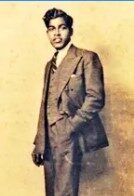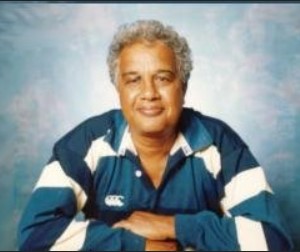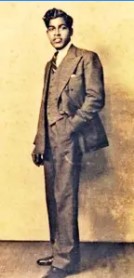General
Young Sabapathipillai Rajanayagam received OBE during World War II-by Dr Michael Roberts


Source:Thuppahis


Logan Thurairatnam, in Daily Mirror, 14 June 2021, with this title “WW2 tribute: Sabapathipillai Rajanayagam youngest to be awarded OBE”
Sabapathipillai Rajanayagam commenced his career in 1934 as a 26-year-old Telegraph Engineer in the Ceylon Central Telegraph Office after completing his undergraduate studies at Imperial College, London. He joined the Signal Corps of the Ceylon Defence Force as a volunteer officer in 1938. When the Japanese entered the war, Rajanayagam was mobilised and sent to Trincomalee. He describes life in Trincomalee to be hard, living in the open. After two months he was demobilised with the rank of Captain and sent back to Colombo as it was deemed that his civil duties in the Central Telegraph Office were more important for the war effort.


The Commander-in-Chief, Admiral Sir Geoffrey Layton had set up a Telecommunications Board composed of representatives from the Army, Navy and Air force. Rajanayagam was appointed a member of that Board as a civilian officer. Signal (communications) requirements for the war effort was discussed and Rajanayagam was made responsible for land-based telecommunication lines.
Lord Mountbatten established his office in Kandy. A dedicated communications cable was laid between India and Ceylon by a British ship, and another cable between Colombo and Trincomalee. Rajanayagam was also responsible for supplying shore-based labour and for the land installation.
Aircraft, including fighter aircraft were based in Colombo, Trincomalee and Koggala, a new seaplane base in southeast Ceylon. Singapore had fallen and the idea was growing that Ceylon would be next.
While patrolling the Bay of Bengal an allied pilot Leonard Joseph Birchall CM, OBE, DFC, OOnt, CD, saw the Japanese fleet in the Bay of Bengal through a gap in the clouds and his message reached Colombo. The pilot was requested to repeat his initial report of the sighting. This message was intercepted by the Japanese, and they realised that the element of surprise was lost. The Japanese shot that plane down, fortunately, the pilot survived and was later referred to as the “Saviour of Ceylon”. This successful reconnaissance enabled the forces in Ceylon to be prepared.
When Japanese planes attacked Colombo harbour on April 05, 1942, fighter aircraft from Trincomalee and Koggala took off to assist the fighters in Colombo. In this big air battle, both sides incurred losses. Subsequently, when Trincomalee was attacked on April 09, 1942, fighters took off from Colombo and Koggala to assist. The significance of this defence was that it was the first time that the Japanese felt real opposition after the fall of Singapore. Sir Winston Churchill was extremely pleased and told his parliament so. The telecommunication lines laid and maintained by Rajanayagam and his staff made it possible to divert the fighter aircraft to where they were needed most. Wireless (radio) was not used for communication as the Japanese were listening to the Allied forces radio communications. Critical communications between the fighter bases, harbours, anti-aircraft batteries and command centres took place via landlines. To complicate matters, the Army cable between Colombo and Trincomalee had been cut and the copper wires stolen by the locals!
Rajanayagam in his memoirs says, “I was rewarded by an OBE. The reward should really have gone to my staff. When attacks by enemy aircraft was expected, I instructed my line staff to patrol their section daily and so my lines worked during the air attacks.” Telephone exchange to telephone exchange communication too, had to be maintained during the air raids.
He further states, “I too worked. The work was carried out in secret. The communication lines had to be continuously tested, repaired, and maintained. Theft of copper lines had to be prevented. The day after Trincomalee was attacked; I went there to give confidence to my staff. They said all civilians had gone, shops were all closed, and they had no food and wanted to leave. I promised to send food to them from Colombo.”
When I returned to Colombo and approached Ragama I found that everything was moving out of Colombo, people on foot and carts filled with furniture, pots and pans. In Colombo after the Colombo air attack, all shops were closed. I could not find a shop to buy food to be sent to my staff in Trincomalee. So, I went to the Civil Defence Commissioner, Sir Oliver Goonetilleke and he sent me with his men with the authority to break open the shops to obtain the necessary foodstuff for my men. So, we went to Maradana and broke open a big shop. We collected rice, dhal and some other food items and sent it with one of my faithful men by train to Trincomalee that very evening. This act was sufficient to convince my men in Trincomalee to remain at their stations”.
The work done by Rajanayagam and his staff must have been extremely vital for the war effort that the O.B.E was awarded in 1943 whilst WW2 was still going on. The following appeared in the Times of Ceylon on June 04, 1943. “Recipients of honours are as a rule men grown grey in service. Rarely is a young public servant singled out for special distinction. The youngest man to be thus honoured, probably the youngest on record in Ceylon, is Mr.S. Rajanayagam, who has been awarded the O.B.E (Civil). He is only 35 years of age.
Born on November 25, 1908, Mr Rajanayagam is a Bsc. (Lond.), A.C.G.I., A.M.I.E.E. He has been in the service of government only nine years, having joined the Telecommunication Department in 1934. He is now Superintending Telecommunication Engineer.
The civil list shows his name quite low in seniority among Telecommunication Engineers, but it is evident that he ranks very high in the estimation of those who are in a position to judge the work done by him.This, I am told, is how this particular reward has come to this young and efficient engineer. He was put on to do some special work and he did it so magnificently that high authority felt that it was a case for special distinction. Mr.Rajanayagam’s future career will be worth watching”.
Rajanayagam’s career spanned 29 years in the Posts & Telecommunications department. He was appointed the Chief Telecommunications Engineer in 1956 and retired in 1963. He passed away in 2012 at the ripe old age of 104.
This article is based on Rajanayagam’s memoirs and letters sent by him to various members of his immediate family. The documents and letters are in the private collection of Premila Thurairatnam, granddaughter of S. Rajanayagam.
Notes:
1 Most likely propaganda as Allied losses were heavy, and the Eastern Naval Fleet was moved to Kenya.
2 Even today wireless internet is not secure. Critical networks are made up of fibre optic cables.
3 The Ceylon public was very aware of the treatment meted out to the locals by Japanese forces, especially in Nanking and Burma. As such they were fleeing Colombo.
13th May 1943
Handwritten letter from the Governor, Sir Andrew Caldecott marked “Secret & Personal” advising Rajanayagam that his name was being submitted to the King for award of the OBE.
Content
Dear Mr Rajanayagam
I have just received a telegram from the Secretary of State saying that, subject to you being agreeable he proposes to submit your name to the King for award of the O.B.E on His Majesty’s Birthday. May I have the pleasure of replying that you are agreeable.
Yours sincerely
Signed
A Caldecott
2nd June 1943: Letter from the Secretary of State Rt Hon Oliver Stanley advising Rajanayagam of the OBE further stating, “This is a well-deserved tribute to your valuable services to Ceylon”.
Content
Colonial Office, Downing Street, SW1.
Dear Mr Rajanayagam
I should like to say how pleased I was to ask the Prime Minister to submit your name to the King for the award of the O.B.E. This is a well-deserved tribute to your valuable services to Ceylon. May I offer you my warm congratulations.
Yours sincerely …………. Signed
Oliver Stanley
2nd June 1943: Telegram from the Governor congratulating Rajanayagam on the award of the OBE.
“It gives me much pleasure to inform you that His Majesty has approved your appointment to be an Officer of the Civil Division of the most excellent Order of the British Empire (Stop) Please accept my cordial congratulations.”
Governor
*********************
A SPECIAL NOTE from Michael Roberts 25 March 2022:
Mr Rajanayagam migrated to Adelaide and I had the pleasure of several long conversations with him before he passed away a decade or so back. These chats were always informative and thought-provoking . I must scour my files and library to see if some results can be found.








